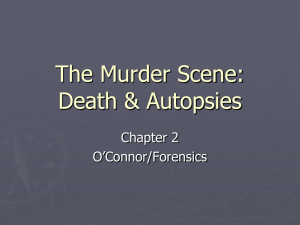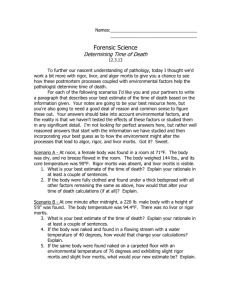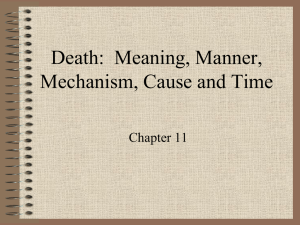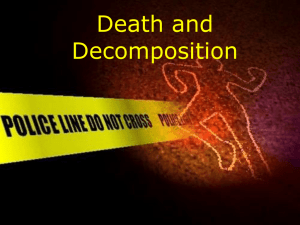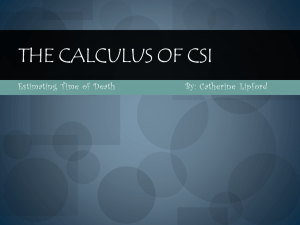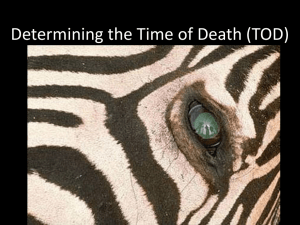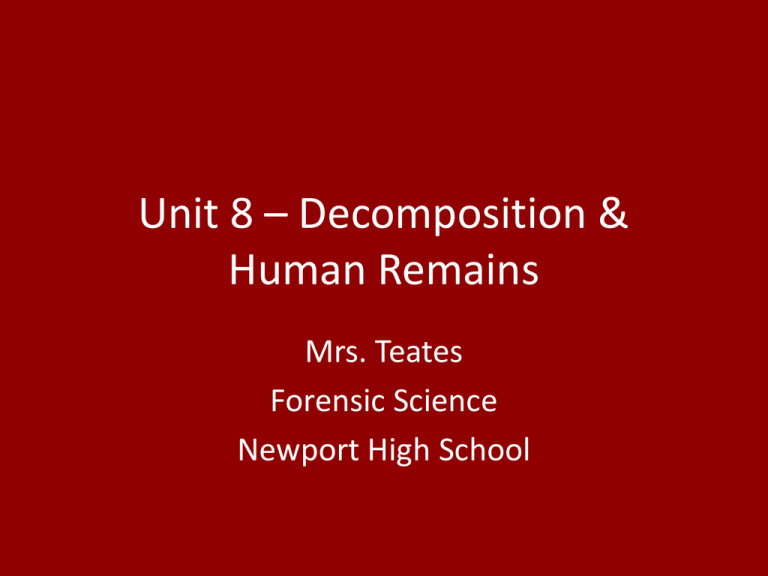
Unit 8 – Decomposition &
Human Remains
Mrs. Teates
Forensic Science
Newport High School
Lesson 1 – Stages of Death
• Lesson Essential Questions:
– What are the stages of death?
Vocabulary:
Algor mortis, glaister equation, livor mortis, rigor
mortis, autolysis, putrefaction, adipocere,
saponification, diagenesis
Rigor Mortis
•
•
•
•
•
Skeletal muscles partially contract
Joints stiffen, lock in place
Onset is 10 minutes to several hours
Rapid cooling can delay it
Lasts up to 72 hours
Chemistry of Rigor Mortis
• Living muscle cells use oxygen to burn glycogen
• After death no oxygen—anaerobic glycosis makes
lactic and pyruvic acids
• pH falls as acidity increases
• Acid promotes a reaction between actin and myosin
which work together to contract the muscle
• Muscle shortens until all ATP and acetylcholine is
used up
Muscle Contraction
End of Rigor Mortis
• The muscles relax when the body starts to
decompose and the fibers begin to break
down
• Intracellular digestive enzymes are released
from the lysosomes as the cells begin to
disintegrate, destroying the muscle fibers
(autolysis)
• Meat is more tender after rigor mortis has
passed (Aged Beef?)
Temperature Dependence of Rigor Mortis
Rigor depends on:
• the type of muscle
fibers
•Temperature
•Stiffen faster at
higher
temperature
Studies of rigor development in rats
http://www.geradts.com/anil/ij/vol_003_no_002/papers/paper001/002.gif
Livor Mortis
• Heart stops beating which had been mixing
blood
• Red blood cells are denser so they sink
• Maroon to blue color develops at lowest
points
• Visible 30 minutes-2 hours after death
• Tells you if the body was moved.
Livor Mortis
• Soon after death, blood is still in vessels, so pressure
on an area pushes the bood out
• As time goes on blood vessels break down as do
blood cells and hemoglobin break down pigment
moves out into the tissues
• Pressure or constrictive clothing prevents blood from
pooling locally
– Contact pallor
Livor Mortis
Livor Mortis
• After death cells release enzyme (fibrinolysins)
that prevents clotting
• Blood in body stays liquid after death
– Permanently won’t clot 30-60 minutes after death
Algor Mortis
• Body cools by
– Radiation
• (the higher the body temperature the more heat lost)
– Conduction depends on surface contact
• faster if in water because enhanced contact
– Convection
• Wind cools faster
• Rate of cooling of body after death
– 1.5 °F per hour under “normal conditions”
– No real conditions are “normal”
Algor Mortis
• Ambient temperature
– Newton’s Law of Cooling
T
k (T (t ) Tambient (t ))
t
• T is body temperature, t is time
• The bigger the temperature difference, the faster the
cooling rate
• Outdoors, temperature varies a lot—must correct
formula by varying Tambient
Algor Mortis
• If ambient temperature is constant, Newton’s
Law of Cooling is easy to solve
• Measure temperature at two different times
without moving the body to find k
kt
T (t ) Tambient (T0 Tambient )e
Algor Mortis
100
Body Temperature (F)
Ambient T
Body T
90
80
70
0
2
4
6
8
Time Since Death (hrs)
10
12
14
Algor Mortis
• Clothing
– Insulates body from heat loss
• Obesity
– Fat insulates, temperature falls more slowly
• Ratio of surface area to volume
– Children, thin people cool faster
• In water?
– Cooling is faster since water is a better conductor
of heat than air
Approximate Times for Algor and Rigor Mortis
.
Algor Mortis
• New issue
– Is there a plateau before body temperature starts
to fall after death?
– May be up to several hours
– Anaerobic cellular chemistry continues after death
– Cellular chemistry releases energy as heat
Testing Potassium Levels in the Eye to
Determine Time of Death
• K concentration is higher inside cells by up to
40X during life
• It takes energy (ATP) to maintain the
difference
Maintaining Concentration Difference in a
Living Cell
Potassium in Ocular Fluid
• At death, no more ATP formation (energy
storage molecule)
• K diffuses out of cells at a constant rate, into
fluid inside the eye
• Time of death
t 7.14Kv 39.1
• Most accurate in first 12 hours after death
• Supposedly independent of temperature
Determining Long Post Mortem Intervals
• Decomposition occurs in stages
– Initial Decay (0-3 days)
• Autolysis--body’s own enzymes destroys tissue
• Begins immediately
– Putrefaction (4-10 days)
• Bacteria in gut leak out
• Anaerobic conditions
• Bloat from hydrogen sulfide, methane, cadaverine,
putrescine released
The Smell of Death
putrescine
cadaverine
Breakdown products from amino acids ornithine and lysine
Amino acid loses CO2
H = white C = turquoise N = blue
Determining Long Post Mortem Intervals
– Black Putrefaction (10-20 days)
• Body collapses
• Liquid seeps into the soil
– Butyric Fermentation (20-50 days)
• Cheesy smell from butyric acid
• Maggots leave
• Beetles arrive
– Dry decay (beyond 50 days)
• Hair is consumed by moths and mites
• Bones are left
Longer Term Estimates of Time of Death
• Monitoring ratios of body decay products in the soil
Dr. Arpad
Vass, ORNL
The Body Farm
U. Tenn.
The first well
controlled
experiments to
explore
decomposition
Identifying Small Molecules
• Gas chromatography
– Presumptive test
• Gas chromatography + mass spectrometry
– Definitive test
• We will discuss these techniques in detail later
in the course!
Volatile Fatty Acid Analysis
Results from the Body Farm
• Depends on temperature
– The hotter, the faster the reactions proceed
– Accumulated Degree Days (sum average daily temp)
– Decay is linear in Accumulated Degree Days
• Depends on whether body was buried or not
– Decay is faster on the surface
• More insect activity
• Warmer—2 feet down is fairly constant 50-55o F
• Decay is slower in acid soil
– Pine forests have very acid soil
• Decay is slower if the body is sprayed with insecticide
Adipocere—Grave Wax
• On bodies are not exposed to insects
• Requires moist anaerobic environment (drowning)
• Hydrolysis of fat to fatty acids and soaps in presence
of bacterial enzymes
• Basic conditions enhance formation
• Prominent on cheeks, buttocks, stomach, breasts
• Resistant to bacteria
– Slows further decomposition
Otzi, the Ice Man
• 5300 year old body
• Found by hikers in Austrian Alps
• Otzi is primarily now adipocere
www.spectroscopynow.com/.../MS_Feb08_otzi.jpg
Summary of Stages of Death
The Process of Death, continued
Stage
Description
Initial or fresh decay (autolysis)
The cadaver appears fresh externally but is
decomposing internally due to the activities of
bacteria present before death (0–4 days).
Putrefaction or bloating
The cadaver is swollen by gas produced internally,
accompanied by the odor of decaying flesh (4–10
days).
Black putrefaction
Flesh of creamy consistency, with exposed body
parts black. Body collapses as gases escape.
Fluids drain from body. Odor of decay very strong
(10–20 days).
Butyric fermentation
Cadaver drying out. Some flesh remains
at first; cheesy odor from butyric acid
(20–50 days).
Dry decay (diagenesis)
Cadaver almost dry; slow rate of decay. May
mummify (50–365 days).
Summary of Decomposition
The Process of Death
Algor Mortis: Body cooling rate
Hours since death =
98.4°F – internal body temperature
1.5
Livor Mortis: skin discoloration caused by pooling of blood
Rigor Mortis: rigidity of skeletal muscles
Temperature of body
Stiffness of body
Time since death
Warm
Not stiff
Not dead more than 3 hours
Warm
Stiff
Dead between 3 and 8 hours
Cold
Stiff
Dead between 8 and 36 hours
Cold
Not stiff
Dead for more than 36 hours
A pathologist estimates time of death from these factors.
Lesson 2 – Forensic Entomology
• Lesson Essential Questions:
– How is the life cycle of insects important in
determining the time of death?
– How do insects play a role in decomposition?
Vocabulary:
Metamorphosis, molt, instar, oviposition, ambient,
mites, eclosion, degree-day, puparia
Taxonomy
Classification of Things in an Orderly Way
We are interested in the phylum, Arthropoda;
class, Insecta; order:
Diptera (flies)
Coleoptera (beetles)
•Entomology
is the study of insects.
Forensic
Entomology
•Forensic entomology involves the use of insects
and other arthropods to aid in legal investigation
•There are three areas of application:
•Insect damage to structures
•Infestation of foodstuffs
•Insects that inhabit human remains
Life Cycle of Insects
Metamorphosis
egg
larva (maggot)
pupa
winged adult
The life cycle of
Musca domestica
Insects arrive at a decomposing body in a
particular
order (succession) and then complete
Time of Death
their life cycle based on the surrounding
temperature. By collecting and studying the
types of insects found on a body and their
metamorphic stage, a forensic entomologist can
estimate the time of death.
Accumulated Degree Hours and Days
• Accumulated degree hour (ADH): a given amount
of thermal energy needed to develop from one
stage of an insect life cycle to the next
• Degree day – amount of development that occurs
in 24 hours
• Accumulated degree day (ADD): a given amount
of days that an insect requires to complete its
development.
– Unique to different species of insects
• ADH and ADD are calculated from temperature
data.
Calculating ADD
1. Calculate the mean (average) temperature
for that day.
2. Compare the mean to the organism’s lower
developmental threshold.
3. If the mean is three degrees higher than the
lower developmental threshold, then there
have been three degree-days.
(Developmental thresholds need to be looked
up for individual insects.)
Calculating ADH
• Calculate degree days and then multiple by
24. This is an approximate value.
Insects of Death
Diptera
First to arrive
Blowflies
Then
Flesh flies
Houseflies
Flies can arrive within minutes. They lay eggs that hatch
to maggots. Maggots feed on soft, mushy body parts.
More insects arrive to feed on the body and each other.
Insects of Death, continued
Coleoptera
In rough order of appearance, from within hours to dry
decay:
Rove beetle
Sexton beetle
Clown beetle
Dermestid beetle
Hide beetle
Some beetles feed on the corpse, some on maggots, some on other beetles.
Temperature
Variables
Affecting
Metamorphosis
The higher
the temperature
(within limits), the
faster the growth.
Habitat
Fly species
can vary
geographically
Variables
Affecting
Metamorphosis,
continued
according to climate, season, and habitat.
Phormia regina
Lucilia illustris
For example, the fly pictured on the left prefers
shade; the one on the right, sunlit areas.
Collection of Evidence
Lesson 3 – The Skeleton & Skeletal
Remains
• Lesson Essential Questions:
– Why is it important for forensic scientists to know
the bones of the human skeleton?
Vocabulary:
Forensic anthropology, osteology, oseons
•Forensic anthropology is a type of applied
anthropology that specializes in the changes
and
variationsAnthropology
in the human skeleton for the
Forensic
purpose of legal inquiry.
•A forensic anthropologist may provide basic
identification information on skeletonized or
badly decomposed remains.
•From a whole bone or part of a bone, the
scientist may be able to determine:
•Age
•Sex
•Race
•Approximate height
•Cause of death
Osteology is the study of bones.
There
are 206 bones in an adult human.
Osteology
Function of bones:
• Provide structure and rigidity
• Protect soft tissue and organs
• Serve as an attachment for muscles
• Produce blood cells
• Serve as a storage area for minerals
• Can detoxify the body by removing heavy metals
and
other foreign elements from the blood
Classifying Bones
• Long bones – longer than they are wide;
include bones in the arms, legs, hands, and feet
• Short bones – approximately as long as they
are wide; they are found in the wrist and ankle
• Flat bones – Flat and enclose soft organs; they
include most bones in the skill and the scapula,
sternum, hip bones, and ribs
• Irregular bones – irregularly shaped; they
include the vertebrae and some of the bones in
the skull
Identifying Bones
• Use the worksheet to identify the major bones
in the body.
Lesson 4 – Determination of
Characteristics from Remains
• Lesson Essential Questions:
– How can sex, gender, age, and race be determined
from the skeleton?
Vocabulary: femur, tibia, humerus
Determining Height of an Individual
• The height of a person can be calculated by
Estimation of Height
measuring the length of certain long bones, including
the femur, tibia, humerus, and radius.
• Below are the equations used to determine average
measurements for both male and female. (All
measurements are in centimeters.)
Male Height, H
Female Height, H
H = femur 2.23 + 69.08
H = tibia 2.39 + 81.68
H = humerus 2.97 + 73.57
H = radius 3.65 + 80.40
H = femur 2.21 + 61.41
H = tibia 2.53 + 72.57
H = humerus 3.14 + 64.97
H = radius 3.87 + 73.50
Age Determination
• Most accurate estimations are made from:
• Teeth
• Epiphyses or growth plates
• Pubic symphysis
• Cranial sutures: The three major cranial sutures appear as
distinct lines in youth and gradually close from the
inside out.
• Investigators always use an age range because of the
variation in people and how they age.
• The investigator does not want to eliminate any possibilities
for identification.
Sagittal suture completely closed
Age Determination Using
Male—26 or older
Female—29 or older
Sagittal suture completely open
Male—less than 32
Female—less than 35
Complete closure of all three major
sutures
Male—over 35
Female—over 50
Cranial Sutures
Sagittal suture
Lambodial
Coronal
Age Determination Using Basilar Suture
Basilar suture
Technically known as the
synchondrosis sphenooccipitalis, closes in
females as young as 14
and in males as young as
16. If the suture is open,
the individual is generally
considered to be 18 or
younger.
• In long bones, the diaphysis makes up most of the
bone’s length.
• Age
The Determination
epiphyses are found at the ends of the bones;
their function is to allow for growth. (Good places to
estimate changes in age.)
• Though all people are different there are similarities
that allow for generalizations in estimating age.
Stage 1: no epiphysis (the growth plate has not formed yet)
Stage 2: non-union; the epiphysis and bone are separate
Stage 3: partial union; the epiphysis is attached, but a line is visible
Stage 4: complete union; the epiphysis is attached and a line is not
visible
The Medial Clavicle in Stages 1–4
Stage of Union
of Medial Clavicle
Male
Female
21 or younger
20 or younger
Non-union with separate
epiphysis
16–21
17–20
Partial union
17–30
17–33
21 or older
20 or older
Non-union without
separate epiphysis
Complete union
Determination of Sex
Gender Differences in Bones
• Determination of sex is crucial to the analysis
of unidentified human remains.
• The pelvis offers the most definitive traits.
• Comparison of three characteristics of the os
pubis gives the information used to identify
sex.
A. The female (top) has a wider pubic body
than the male (bottom).
Gender Identification
B. The female has a wider subpubic concavity or subpubic
angle.
C. Most females have a ventral arc present.
Human Remains
Male
Female
Subpubic Angle
18
Determine which are male and which are female. On
page 420 in the textbook.
Other ways to determine sex of the
individual
• The rib cage and shoulders of males
are generally wider and larger than
those of females.
• In addition, about one person in 20
has an extra rib.
• This is more common in males than in
females.
• In males, the index finger is
sometimes shorter than the third
finger. In females, the index finger is
sometimes longer than the third
finger. This is not often used as an
indicator of gender, as there are many
exceptions.
• The rib cage and
shoulders
of males are
Gender Differences
generally wider and
larger than those of
females.
• In addition, about one
person in 20 has an
extra rib.
• This is more common
in males than in
females.
Determining Race
• Race is difficult to determine from most skeletal remains, especially
Race
since pure races are becoming uncommon.
• An experienced forensic anthropologist can generally place skulls
into one of three groups:
• Caucasoid—European, Middle Eastern, and Indian descent
• Negroid—African, Aborigine, and Melanesian descent
• Mongoloid—Asian, Native American, and Polynesian descent
Caucasoids—have a long, narrow nasal aperture, a triangular palate, oval
orbits, narrow zygomatic arches, and narrow mandibles.
Negroids—have a wide nasal aperture, a rectangular palate, square orbits,
and more pronounced zygomatic arches. The long bones are longer, and have
less curvature and greater density.
Mongoloids—have a more rounded nasal aperture, a parabolic palate,
rounded orbits, wide zygomatic arches, and more pointed mandibles.
What differences do you notice among these
three skulls? Can you determine race?
Using Teeth to Determine Identity
•
•
The Odontology
identity of an individual can be
determined
by of
comparing
The Study
Teeth a
person’s teeth to his or her dental
records.
Unusual features including the
number and types of teeth and
fillings, the spacing of the teeth,
and/or special dental work help to
make a positive identification.
Teeth are often used for body
identification because:
They are the hardest substances
in the body (they do not readily
decompose).
They are unique to the individual.
X rays are a good record of a
person’s teeth, giving them a
unique identity.
Facial Reconstruction
• After determining the sex,
Facial
Restoration
age, and race of an
individual, facial features
can be built upon a skull to
assist in identification.
• Erasers are used to make
tissue depths at various
points on the skull.
• Clay is used to build
around these markers, and
facial features are molded.
Steps in Facial Reconstruction
With a skull:
Establish age, sex, and race.
Plot landmarks for tissue
thickness.
Plot origin and insertion points
for muscles.
Plot landmarks for facial
features.
Select a dataset and mount
markers for tissue thickness.
Mount the eyes.
Model muscles on skull.
Add fatty tissue around
eyes and lacrimal
glands.
Add eyelids.
Add the nose.
Add the parotid gland.
Add the ears.
Cover all with layers of
skin.
Detail the face.
Animal Facial Restoration
Determining what T. Rex looked like using the bone formation.
From this:
To this:
Forensic experts may be called upon
to give information on the life and death
of humans
animals in unique
More and
Applications
circumstances, including:
• Mass murder (Oklahoma bombing,
plane crashes, World Trade Center)
• Earlier man (mummies, Iceman, Lindow
Man)
• Historical significance (Holocaust,
uncertain death of famous people)
• Prehistoric animals (dinosaurs)
The Body Farm was created to help
forensic experts with this task.
The Body Farm
• The Body Farm is the nickname of a two-and-a-halfacre research facility in Tennessee developed in
1980 by Bill Bass where bodies are placed in various
conditions and allowed to decompose.
• Its main purpose is to observe and understand the
processes and timetable of postmortem decay.
• Over the years it has helped to improve the ability to
determine “time since death” in murder cases.
Hic locus est ubi mortui viveuntes docent.
“ This is the place where the dead teach the living.”
Case Study
Case Study: Facial Reconstruction
John List killed his entire family, moved to a new town, and
assumed a new identity. Seventeen years later, Frank
Bender reconstructed what he believed List would look like.
The reconstruction was shown on America’s Most Wanted,
and he was turned in by the viewers almost immediately . . .
looking very much like the reconstruction.
Check out more about this story on truTV’s Crime
Library:
www.crimelibrary.com/notorious_murders/family/list/1.h
tml
Anthropologist at Work
This anthropologist is
hard at work dusting
away material from
these embedded bones.
Picture taken at
Chicago’s Museum
of Natural History

